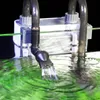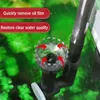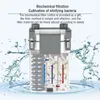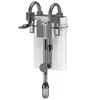Are you facing issues with your water heater thermostat in your aquarium? Common problems include inaccurate temperature readings, inconsistent temperatures, and overheating or underheating. These issues can be caused by wear and tear, mechanical malfunction, or incorrect placement of the heater. To fix these issues, try testing and calibrating the thermostat, or consider replacing it altogether. Preventative measures such as regular maintenance, proper placement, and investing in a high-quality thermostat can also help avoid future problems. By following these tips, you can ensure that your aquarium’s water heater thermostat functions smoothly and keeps your aquatic pets comfortable.





Common Issues with Water Heater Thermostats in Aquariums
One common issue with water heater thermostats in aquariums is inaccurate temperature readings. This problem arises when the thermostat fails to detect the actual temperature of the water, leading to incorrect readings. Inaccurate temperature readings can have serious consequences for fish and other aquatic animals, as they may not be able to survive in water that is too hot or too cold. To avoid this problem, it’s important to regularly calibrate your thermostat and ensure that it’s functioning correctly.
Another issue that consumers may face with water heater thermostats is a failure to maintain consistent temperature levels. This can occur due to a variety of reasons, including poor insulation, power fluctuations, or a faulty thermostat. Inconsistent temperatures can cause stress for fish, leading to health problems and even death. To prevent this from happening, it’s important to invest in a high-quality water heater thermostat that has a reliable temperature control system.
Overheating or underheating the aquarium is also a common issue associated with water heater thermostats. Overheating occurs when the thermostat fails to shut off the heater, causing the water temperature to rise above safe levels. On the other hand, underheating can happen when the thermostat fails to turn on the heater, resulting in water that is too cold. Both of these scenarios can be harmful to aquatic life, which is why it’s crucial to monitor the water temperature regularly and replace any faulty equipment as soon as possible.
Causes of these Issues
Water heater thermostats can sometimes be a source of frustration for homeowners when they start to malfunction. There are several reasons why these issues occur, including wear and tear, mechanical malfunction, and placement of the heater. In this article, we will discuss these common causes of water heater thermostat problems and provide some tips on how to fix them.
Wear and Tear
After prolonged use, the components of a water heater thermostat may start to wear out. In particular, the thermostat’s sensor may become less precise, resulting in inaccurate temperature readings. This can cause the water to be too hot or too cold, leading to discomfort or even scalding. Additionally, the thermostat’s contacts may become worn, leading to poor electrical connections and an increased risk of electrical hazards.
To prevent these issues, it is important to perform routine maintenance on your water heater. You should check the thermostat’s accuracy using a thermometer and adjust it as necessary. Additionally, you should inspect the thermostat’s wiring and contacts for any signs of corrosion or damage. If you notice any issues, you should replace the damaged components as soon as possible.
Mechanical Malfunction
Another common cause of water heater thermostat problems is mechanical malfunction. This can occur due to a variety of reasons, such as a faulty heating element or a defective thermostat control board. These issues can cause the water heater to stop working entirely or produce insufficient hot water.
To diagnose these issues, you should inspect the water heater’s heating elements and thermostat control board for any signs of damage or wear. If you notice any issues, you should replace the damaged components. Additionally, you may need to flush the water heater to remove any sediment that has accumulated in the tank, which can reduce its efficiency and lifespan.
Placement of the Heater
Finally, the placement of the water heater can also affect its performance. For example, if the water heater is located in an area with low ambient temperatures, such as a basement or garage, it may struggle to maintain a consistent temperature. This can result in fluctuating water temperatures or even frozen pipes.
To address these issues, you should consider moving the water heater to a more suitable location or installing insulation around the tank and pipes. Additionally, you may need to adjust the thermostat to compensate for the lower temperatures.
How to Fix the Issues
Fortunately, there are steps you can take to fix these issues. In this article, we will discuss three methods for addressing thermostat problems: testing, calibrating, and replacing.
Testing the Thermostat
Before taking any drastic measures, it is important to test your thermostat to ensure that it is truly the source of the issue. To do this, turn off power to your water heater and locate the thermostat. Depending on the type of water heater, the thermostat may be located behind a cover plate or exposed on the front of the unit.
Using a multimeter, test the thermostat by placing one probe on each terminal of the thermostat. You should see a reading of around 240 volts if the thermostat is functioning properly. If you notice a significant deviation from this reading, your thermostat may be the culprit.
Calibrating the Thermostat
If your thermostat is reading incorrectly, it may simply need to be calibrated. This involves adjusting the temperature setting to match the actual temperature of your water heater. To do this, you will need to adjust the screws on the thermostat using a screwdriver.
Be sure to refer to your water heater’s manual for specific calibration instructions. It is important to note that over-calibration can lead to overheating and potential safety hazards, so exercise caution when making adjustments.
Replacing the Thermostat
If testing and calibration do not resolve the issue, it may be time to replace your thermostat. This process typically involves disconnecting the wires from the old thermostat and installing the new one in its place.
It is important to choose the correct replacement thermostat for your water heater model. Consult your water heater’s manual or contact a professional plumber for assistance if needed.
Preventative Measures
A water heater is an essential appliance in any household, providing hot water for showers and cleaning. However, like any other appliance, it requires regular maintenance to ensure that it continues to function correctly. One crucial component of a water heater is the thermostat, which controls the temperature of the water. In this article, we will discuss preventative measures that you can take to keep your water heater thermostat functioning optimally.
Regular Maintenance and Cleaning
One of the easiest ways to prevent issues with your water heater thermostat is by performing regular maintenance and cleaning. Over time, sediment and mineral buildup can accumulate in the tank, creating a barrier between the heating element and the water it heats. This buildup can cause the thermostat to work harder than necessary or even fail. Regular flushing of the tank and cleaning of the thermostat can help prevent this buildup from occurring.
Proper Placement of the Heater
The placement of your water heater can also have an impact on its functionality. If the heater is placed in an area that is too cold, such as a basement or garage, it may struggle to maintain the desired temperature. Conversely, if it is placed in an area that is too warm, such as a utility closet, it may not turn on when it needs to. Ensuring that your water heater is placed in an area with optimal temperature conditions can help prevent thermostat issues.
Investing in a Good Quality Thermostat
While it may be tempting to purchase a cheaper thermostat, investing in a good quality one can save you money in the long run. A high-quality thermostat will be more accurate and reliable, helping to prevent issues with overheating or underheating. Additionally, some thermostats come equipped with features such as programmable settings, which can help save energy costs.
In conclusion, preventative measures such as regular maintenance and cleaning, proper placement of the heater, and investing in a good quality thermostat can help keep your water heater functioning optimally. By following these steps, you can ensure that your water heater thermostat continues to provide you with hot water when you need it.
FAQ 1: Why is my aquarium water heater not heating up the water to the set temperature?
Answer: The most common reason for this issue is a faulty thermostat. If the water heater thermostat is not functioning correctly, it may not be able to regulate the temperature of the water in the aquarium. In such cases, you can try resetting the thermostat or replacing it if necessary. Another reason could be that the heater wattage is insufficient for the size of your aquarium, so check the heater specs to ensure proper sizing.
FAQ 2: How do I know if my water heater thermostat is faulty?
Answer: One of the signs of a faulty thermostat is that the temperature of the water in the aquarium does not match the set temperature. You may also notice that the heater is constantly on and off, which could indicate that the thermostat is not working as it should. Additionally, if you hear a clicking sound from the heater, it could mean that the thermostat is unable to maintain a constant temperature.
FAQ 3: Can I fix a faulty water heater thermostat myself?
Answer: If you have experience with aquarium maintenance, you may be able to replace a faulty thermostat yourself. However, if you are unsure about how to proceed, it is best to seek professional help. Improper installation or replacement of the thermostat can cause damage to the heater and pose a threat to the safety of your aquarium inhabitants.
FAQ 4: How often should I check the water heater thermostat in my aquarium?
Answer: Regular checks are necessary to ensure that the thermostat is functioning correctly. You should check the temperature of the aquarium water once a day to ensure that it matches the set temperature. If you notice any discrepancies, you should investigate further to determine the root cause of the problem. It is also recommended to replace the thermostat every two years to avoid potential issues.

